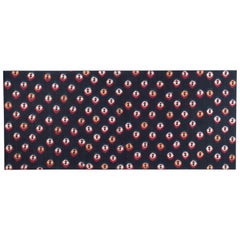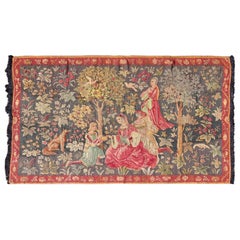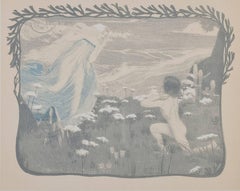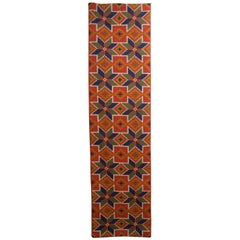Tapestry From 1900
to
2
4
1
2
2
2
2
2
1
1
1
1
Sort By
Tie-Dyed Panel from Tibet, circa 1900
Located in Point Richmond, CA
Tie-dyed panel from Tibet, circa 1900.
Woven on a back-strap loom by nomadic Tibetans, this type
Category
Antique Late 19th Century Tibetan Tribal Tapestries
Materials
Wool
Antique French Tapestry in Gray Background and Vibrant Colors
Located in Atlanta, GA
Measures: 4'11 x 7'5.
This Beautiful Scenery design antique French tapestry from the early 1900's
Category
Antique Early 1900s French Aubusson Tapestries
Materials
Wool
"H. L'Illusion (L'Estampe Moderne I), " Original Color Lithograph
By Henri Bellery-Desfontaines
Located in Milwaukee, WI
Français hosted one of his design of tapestry.
From 1900 on, he gradually evolved toward an ambitious
Category
1890s Art Nouveau Figurative Prints
Materials
Lithograph
Traditional Large Handwoven Wool Wall Hanging from Skåne in South of Sweden
Located in Malmo, SE
A beautiful traditional large handwoven wool wall hanging from Skåne in south of Sweden, problaby from Oxie or Skytts Härad according to the colours and pattern.
This large wall ha...
Category
Antique Early 1900s Swedish Tapestries
Materials
Cotton, Wool
H 0.4 in W 17.72 in D 63 in
French Loomed Sphinx Tapestry, circa 1900
Located in New York, NY
A French loomed Sphinx tapestry from circa 1900, portraying a desert scene with Egyptian locals
Category
Antique 18th Century French Tapestries
Materials
Wool
Get Updated with New Arrivals
Save "Tapestry From 1900", and we’ll notify you when there are new listings in this category.
Tapestry From 1900 For Sale on 1stDibs
Choose from an assortment of styles, material and more with respect to the tapestry from 1900 you’re looking for at 1stDibs. A tapestry from 1900 — often made from fabric, wool and cotton — can elevate any home. There are 352 variations of the antique or vintage tapestry from 1900 you’re looking for, while we also have 1 modern editions of this piece to choose from as well. There are many kinds of the tapestry from 1900 you’re looking for, from those produced as long ago as the 18th Century to those made as recently as the 21st Century. A tapestry from 1900 is a generally popular piece of furniture, but those created in folk art, Art Nouveau and louis xv styles are sought with frequency. Many designers have produced at least one well-made tapestry from 1900 over the years, but those crafted by Adja Yunkers, Léon Jallot and Aubusson Manufacture are often thought to be among the most beautiful.
How Much is a Tapestry From 1900?
The average selling price for a tapestry from 1900 at 1stDibs is $4,200, while they’re typically $106 on the low end and $750,000 for the highest priced.
Questions About Tapestry From 1900
- What is a tapestry?1 Answer1stDibs ExpertFebruary 22, 2021A tapestry is a piece of hanging textile art that contains pictures or designs. A tapestry is created by weaving colored weft threads or by embroidering directly onto canvas.
- What is embroidered tapestry?1 Answer1stDibs ExpertApril 5, 2022Tapestries are thick, textile art that’s often hung from the wall as a method of displaying it. Embroidery is a type of needlework that uses counted threads and stitches to create patterns or images. An embroidered tapestry is a fabric wall hanging that features the art of embroidery for visual impact. On 1stDibs, find a variety of original artwork from top artists.
- What is Flemish tapestry?1 Answer1stDibs ExpertApril 5, 2022A Flemish tapestry is a decorative woven wall hanging produced in Flanders, primarily during the 15th, 16th and 17th centuries. Peter Paul Rubens and Bernard van Orley are two of the most famous Flemish artists to work in the medium. You'll find a variety of Flemish tapestries on 1stDibs.
- Where can I buy tapestries?3 Answers1stDibs ExpertFebruary 22, 2021You can buy tapestries on 1stDibs.com. 1stDibs has a variety of different tapestries in different colors, patterns, and prices.
 Antique Textiles GalleriesFebruary 25, 2021Most of our textiles, tapestries, furnishings and pillows are available through 1stdibs. A.T.G.H.C’s beautifully crafted and hand sewn work exhibits our creative eye for detail in made-to-order luxury throw pillows and furnishings with the exceptional textiles of our vast collection.
Antique Textiles GalleriesFebruary 25, 2021Most of our textiles, tapestries, furnishings and pillows are available through 1stdibs. A.T.G.H.C’s beautifully crafted and hand sewn work exhibits our creative eye for detail in made-to-order luxury throw pillows and furnishings with the exceptional textiles of our vast collection. NazmiyalMarch 23, 2021You can find many of our Tapestries on the 1st dibs platform.
NazmiyalMarch 23, 2021You can find many of our Tapestries on the 1st dibs platform. - How are tapestries made?1 Answer1stDibs ExpertSeptember 25, 2019
Tapestries are handwoven on a loom is such a way that only the weft (horizontal) threads are visible.
- What are tapestries made of?1 Answer1stDibs ExpertFebruary 27, 2024Tapestries are made out of a wide range of materials. Wool is arguably the most commonly used to produce the threads for weaving tapestries. In some cases, silk or metallic threads will be mixed in with wool for added luster. Some weavers opt for other materials, such as cellulose and cotton. Find a selection of tapestries on 1stDibs.
- What do tapestries symbolize?1 Answer1stDibs ExpertMay 14, 2024What tapestries symbolize is largely a matter of individual interpretation. Because early examples graced the walls of palaces and grand estates, many people associate them with wealth, royalty, power and prestige. Individual tapestries may symbolize different themes based on the images and symbols that they display. For example, art historians believe the medieval Lady and the Unicorn tapestries represent the five human senses: sight, hearing, taste, touch and smell. On 1stDibs, shop a selection of tapestries.
- Can you frame a tapestry?1 Answer1stDibs ExpertFebruary 22, 2021You can frame a tapestry using a tapestry frame, which works to keep the canvas taut and hang the item. There are many different types of tapestry frames, though a popular one has a top wooden clamp with a hanging mechanism and a bottom wooden clamp to weigh down the material.
- What is a tapestry used for?1 Answer1stDibs ExpertFebruary 22, 2021Tapestries is a decorative piece of heavy fabric that's usually hand-woven. It can be used as wall art, to cover furniture, or as an area rug.
- Where did tapestry originate?1 Answer1stDibs ExpertFebruary 13, 2024Historians are not completely sure where tapestries originated. Ancient literature from Rome, Greece and other civilizations does not specifically mention tapestries, but that doesn't mean that they didn't exist. We do know that the Ancient Egyptians did produce and utilize tapestries, as examples have been discovered in the tombs of Thutmose IV and Tutankhamen. The word tapestry wasn't coined until the 15th century, and it originated in England. Find a wide variety of tapestries on 1stDibs.
- What was a sofa called in 1900?1 Answer1stDibs ExpertSeptember 27, 2024What a sofa was called in 1900 varied. During the 18th and 19th centuries, many people called small sofas “settees” and large ones “sofas,” but by the 20th century, settee and sofa were interchangeable terms. Other terms for sofas included davenport, divan, lounge and couch. On 1stDibs, shop a wide variety of antique, vintage and contemporary sofas.
- 1stDibs ExpertApril 5, 2022By definition, tapestries are woven textiles, not embroidered fabrics. However, you will sometimes see people refer to embroidered wall hangings as tapestries because both types of decorative textiles function as wall décor. On 1stDibs, shop a large collection of tapestries.
- 1stDibs ExpertApril 5, 2022To know if a tapestry is valuable, seek the help of a licensed appraiser. Because condition has a big impact on what a tapestry is worth, you will need an expert to thoroughly inspect the textile. On 1stDibs, find a range of expertly vetted tapestries.
- 1stDibs ExpertApril 5, 2022Yes, William Morris made some tapestries. William Morris was a true artisan and delved into a variety of different areas. He’s also credited with ushering in the Arts and Crafts movement in England. He held a lot of respect for those who could produce tapestries and made his first one in 1879. He learned more and created more tapestries but also established a small tapestry workshop where he employed tapestry weavers. Shop a collection of tapestries from some of the world’s top sellers on 1stDibs.
- 1stDibs ExpertJune 15, 2023In the 1900s, wedding dresses typically looked like full, floor-length garments. Brides wore S-shaped corsets below the usually ruffled bodices, and most designs included large puff sleeves. On 1stDibs, shop a variety of vintage wedding dresses from some of the world's top boutiques.
- 1stDibs ExpertNovember 21, 2023In the early 1900s, engagement rings often looked like other jewelry from the Edwardian era, which coincided with the reign of King Edward VII in the United Kingdom from 1901 to 1910. Cutters used new diamond saws and jewelry lathes to refine the old European cut. The resulting stones, designed to sparkle in the light from candles and gas lamps, are beloved by connoisseurs for their inner fire and romantic glow. The invention of the oxyacetylene torch enabled jewelers to use platinum, which had previously been too challenging to work with. This technological advancement made it possible for Edwardian rings to show off lacy filigree and milgrain work. Nature also influenced jewelry in the early 1900s. Flowing and floral garland motifs were so popular that the Edwardian age is sometimes called the "garland era." Find a selection of Edwardian engagement rings on 1stDibs.




